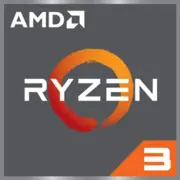AMD Ryzen 3 7320C

AMD Ryzen 3 7320C: Compact Power for Everyday Tasks
Overview of the 2025 Ultrabook Processor
Architecture and Technology Process: A Balance Between Efficiency and Performance
The AMD Ryzen 3 7320C is built on the Zen 2 architecture, adapted for TSMC's 6nm FinFET technology. This allows for reduced power consumption without sacrificing performance. With four cores and eight threads (thanks to SMT technology), it ensures multitasking capabilities, while a base frequency of 2.4 GHz and turbo boost up to 4.1 GHz make the chip responsive in everyday scenarios.
The integrated Radeon 610M graphics utilize a trimmed-down version of the RDNA 2 architecture, featuring just 2 compute units (CUs) and a frequency of up to 1.9 GHz. This is sufficient for 4K output, office applications, and undemanding games. The 4 MB L3 cache optimizes data processing, reducing latency.
Power Consumption and TDP: Comfort for Ultrabooks
With a TDP of 15 W, the Ryzen 3 7320C is positioned as a solution for thin and light laptops. This thermal package allows for passive or compact active cooling, which reduces noise and thickness of the chassis. However, in turbo mode, power consumption can briefly peak at 25 W, potentially leading to temperatures of 70–75°C in budget models under load.
Performance: From Office Tasks to Light Gaming
Office Work and Multimedia:
- In Geekbench 6 tests (1150 points in Single-Core, 3421 in Multi-Core), the processor performs at a level comparable to the Intel Core i5-1135G7. This means it can easily handle dozens of browser tabs, document editing, and video conferencing.
- Converting a 10-minute 1080p video in HandBrake takes about 4–5 minutes—a modest but acceptable result for basic tasks.
Gaming:
- In Dota 2 at low settings (720p), the Radeon 610M delivers 35–40 FPS, while in CS:GO, it achieves up to 50 FPS. For games like Fortnite or Genshin Impact, reducing the resolution to 720p and turning off effects may be necessary.
Turbo Mode:
When turbo frequencies are activated (for instance, in Adobe Photoshop), the processor can briefly boost to 4.1 GHz, reducing rendering time by 15–20%. However, in laptops without effective cooling, this mode can cause throttling.
Use Cases: Who Is the Ryzen 3 7320C Made For?
- Students and Office Workers: text processing, spreadsheets, Zoom/Teams meetings.
- On-the-Go Users: long battery life and lightweight devices (laptops starting from 1.2 kg).
- Casual Gamers: games with low requirements or streaming via cloud services.
- Home PCs: media centers for 4K video viewing.
Battery Life: How Long Will It Last?
Thanks to a TDP of 15 W and AMD's Power Efficiency optimizations, laptops with the Ryzen 3 7320C demonstrate 8–10 hours of operation under moderate load (web browsing, YouTube viewing). In power-saving mode (enabled through AMD Adrenalin software), this time can extend up to 12 hours.
Energy-Saving Technologies:
- Precision Boost 2: dynamic load distribution among cores.
- Core Parking: disabling unused cores.
- Adaptive Voltage Control: reducing voltage while idle.
Comparison with Competitors: What Should You Choose?
- AMD Ryzen 5 7520U: $50–100 more expensive, but offers 6 cores and Radeon 660M for gaming.
- Intel Core i3-1415U (15W): similar price ($400–600 for laptops), but better performance in single-threaded tasks (+10–15% in Geekbench).
- Apple M1 (in MacBook Air): outperforms Ryzen 3 in energy efficiency and rendering speed but is limited to macOS and costs more ($899+).
- Previous Generation (Ryzen 3 5300U): Ryzen 3 7320C is 20% more power-efficient and cooler.
Pros and Cons
Strengths:
- Ideal for lightweight laptops with 10+ hours of battery life.
- Supports Wi-Fi 6E and USB4 for modern peripherals.
- Affordable devices ($400–600).
Weaknesses:
- Weak integrated GPU for modern gaming.
- Only 4 cores—multi-core performance lags behind Ryzen 5 and Core i5.
Recommendations for Laptop Selection
1. Device Type: ultrabooks (Acer Swift 3, HP Pavilion Aero) or budget Chromebooks with Windows.
2. RAM: at least 8 GB LPDDR5 (preferably 16 GB for multitasking).
3. Storage: SSD 256 GB (NVMe speeds up OS loading).
4. Display: IPS matrix with Full HD resolution (avoid TN screens).
5. Ports: USB-C with charging support, HDMI 2.0 for external monitors.
Final Conclusion
The AMD Ryzen 3 7320C is a solid choice for those who value mobility and aren't looking to pay for excess power. It is suitable for:
- Students for studying and light relaxation.
- Office Workers who need a reliable tool.
- Travelers who appreciate battery life.
Key advantages include low price, energy efficiency, and sufficient performance for basic tasks. However, for serious gaming or 3D graphics work, consider models with Ryzen 5/7 or dedicated graphics cards.
Basic
CPU Specifications
Memory Specifications
GPU Specifications
Miscellaneous
Benchmarks
Compared to Other CPU
Share in social media
Or Link To Us
<a href="https://cputronic.com/en/cpu/amd-ryzen-3-7320c" target="_blank">AMD Ryzen 3 7320C</a>